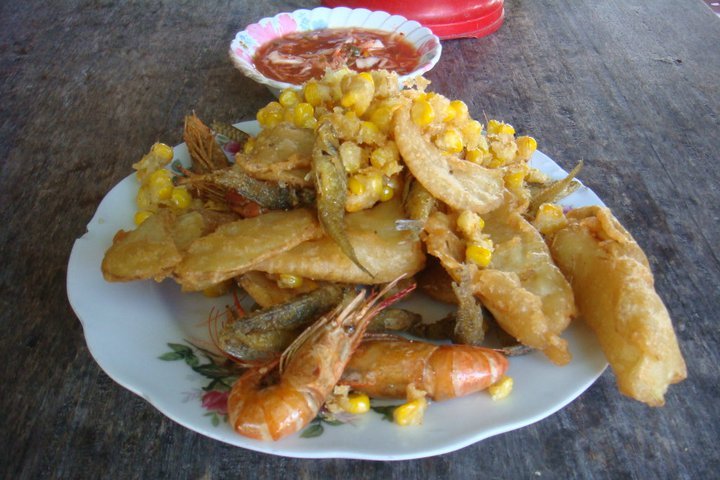
On Friday, 16 July 2021, Thammasat University students are cordially invited to join a free online seminar, Disruption and Food Security in South Asia.
The Thammasat University Library collection includes several books about different aspects of food security.
The event presented by Monash Business School, Monash University, Australia will be held at 3pm Bangkok time.
The event webpage explains:
Major disruptions, such as the COVID-19 pandemic, climate-related natural disasters, conflicts and political instability, threaten food security in low-income communities. In South Asia in particular, the combination of threats amplifies their devastating impact on poor communities in climate-vulnerable areas. In this webinar, a panel of food policy experts will give presentations on the environmental and political threats facing disadvantaged communities in rural South and Southeast Asia, and the impact of COVID-19 on incomes, coping strategies and food insecurity in India, Nepal, and Myanmar. Presentations will be followed by a discussion on government measures needed to address these challenges.
For any further questions or additional information, kindly write to this email address:
buseco-events@monash.edu
Thailand and food security
According to the website of the International Food Policy Research Institute (IFPRI),
Food security, as defined by the United Nations’ Committee on World Food Security, means that all people, at all times, have physical, social, and economic access to sufficient, safe, and nutritious food that meets their food preferences and dietary needs for an active and healthy life.
Over the coming decades, a changing climate, growing global population, rising food prices, and environmental stressors will have significant yet uncertain impacts on food security. Adaptation strategies and policy responses to global change, including options for handling water allocation, land use patterns, food trade, postharvest food processing, and food prices and safety are urgently needed. IFPRI’s work on food security includes analysis of cash transfers, promotion of sustainable agricultural technologies, building resilience to shocks, and managing trade-offs in food security, such as balancing the nutritional benefits of meat against the ecological costs of its production.
IFPRI’s research on this topic is closely aligned with the Sustainable Development Goals (SDGs), including SDG 1, SDG 2, and SDG 3.
A 2016 IFPRI research report is available for free download online:
Local to National: Thailand’s Integrated Nutrition program
Thailand reduced child undernutrition by more than half within one decade—an achievement recognized by the nutrition community as one of the best examples of a successful national nutrition program. Underweight rates among children under five decreased from more than 50 percent to less than 20 percent from 1982 to 1991, and severe and moderate underweight rates were nearly eliminated. The underweight rate was further reduced to 10 percent by 1996 and to 9 percent by 2012. Maternal care interventions were also successful. Thailand improved the reach of antenatal care—coverage increased from 35 percent in 1981 to near 95 percent in 2006.5 And iron-deficiency anemia prevalence among pregnant women was reduced from nearly 60 percent in the 1960s to 10 percent in 2005. Thailand’s gains in nutrition were driven in large part by strong political will, clear goals, effective strategic and program planning, and sustained integrated action and systematic monitoring. Most notably, this success was fueled by widespread mobilization of volunteers and by community ownership. Nutrition was recognized as a fundamental element of development at all levels of society and across sectors ranging from health and agriculture to education and rural development. Communities were supported by government officials and professional experts in assessing their basic needs and creating development plans based on their priorities. Ongoing monitoring increased community awareness about the importance of nutrition and fed back to policies and programs at district and national levels.

However, as the Bangkok Post reported in February, some issues remain across Asia and in the Kingdom:
The economic impact of Covid-19 on the world’s most populous region is further undermining efforts to improve diets and nutrition of nearly 2 billion people who were already unable to afford healthy diets.
As many as 1.9 billion people in Asia and the Pacific were unable to afford a healthy diet, even before the Covid outbreak and the damage it caused to economies and individual livelihoods, research by United Nations agencies shows.
Supply chain disruptions have pushed up prices for many basic foods including fruits, vegetables and dairy products, making it even harder for poor people to achieve healthy diets.
Affordability is critical to ensure food security and nutrition for all — and for mothers and children in particular, says a report entitled “Asia and the Pacific Regional Overview of Food Security and Nutrition 2020: Maternal and Child Diets at the Heart of Improving Nutrition”.
“Food prices and available incomes govern household decisions on food and dietary intake. But the outbreak of Covid and a lack of decent work opportunities in many parts of the region, alongside significant uncertainty of food systems and markets, has led to a worsening of inequality, as poorer families with dwindling incomes further alter their diets to choose cheaper, less nutritious foods,” says the report jointly published by the Food and Agriculture Organization (FAO), the UN Children’s Fund, the World Food Programme and the World Health Organization (WHO).
According to the report, more than 350 million people in Asia Pacific were undernourished in 2019, representing roughly half of the global total. Across the region, an estimated 74.5 million children under 5 years of age were stunted, or too short for their age, and 31.5 million suffered from wasting, defined as being too thin for their height.
The majority of these children live in South Asia, where nearly 56 million are stunted and more than 25 million display signs of wasting. At the same time, overweight and obesity has increased rapidly, especially in Southeast Asia and the Pacific, with an estimated 14.5 million children under five, being overweight or obese.
“Poor diets and inadequate nutritional intake is an ongoing problem,” the report says. “The cost of a healthy diet is significantly higher than that of a diet that provides sufficient calories but lacks nutritional value, showing significant gaps in the food system to deliver nutritious options to all at an affordable price. These costs are even greater for women and children, given their added nutritional needs.”
Food accessibility has become a real concern in light of higher food prices and income reduction during the pandemic, according to Witsanu Attavanich, an associate professor of economics at Kasetsart University.
In Thailand, the prevalence of high food prices is more severe in the North than in other regions, mainly because the food marketing structure varies between different parts of the country.
Household debt, which has reached an all-time high of 86.7% of gross domestic product (GDP), affects the four pillars of food security: availability, access, utilisation, and stability of the first three pillars, said Dr Wissanu.
High food prices during the first and second waves of the coronavirus outbreak stemmed from declining volumes of food produced, increasing input prices and transport costs, and higher demand, partly because more people were cooking at home out of necessity.
(All images courtesy of Wikimedia Commons)

